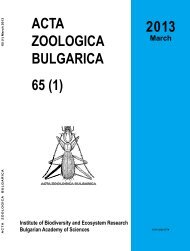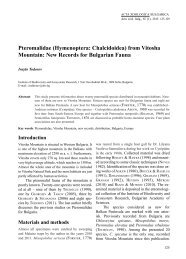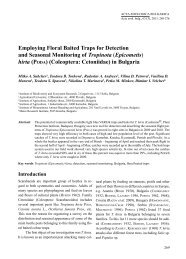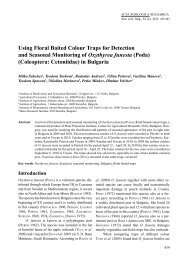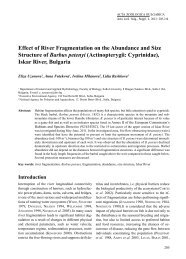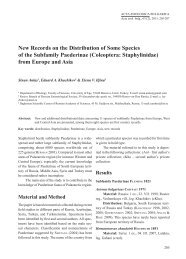Acta zoologica bulgarica
Zi-Wei Yin.indd - Acta zoologica bulgarica
Zi-Wei Yin.indd - Acta zoologica bulgarica
- No tags were found...
You also want an ePaper? Increase the reach of your titles
YUMPU automatically turns print PDFs into web optimized ePapers that Google loves.
<strong>Acta</strong> <strong>zoologica</strong>ISSN 0324-0770<strong>bulgarica</strong>62 (3) • Sofia • December • 2010Institute of ZoologyBulgarian Academy of SciencesInformation on the contents of this journal is indexed in the following Thompson Reuters services:• Science Citation Index Expanded (SciSearch ®)• Journal Citation Reports/Science Edition• Biological Abstracts• BIOSIS Previews• Zoological RecordThis issue is financially supported by the Bulgarian Academy of Sciences,and the Ministry of Education and Science – National Science Fund
ACTA ZOOLOGICA BULGARICA<strong>Acta</strong> zool. bulg., 62 (3), 2010: 247-251Genus Horniella (Coleoptera: Staphylinidae: Pselaphinae)New to the Chinese Fauna, with Descriptionof a Second New SpeciesZi-Wei Yin 1 , Li-Zhen Li 1 & Mei-Jun Zhao 1,*1Department of Biology, College of Life and Environmental Sciences, Shanghai Normal University, 100 Guilin Road, Shanghai,200234, P. R. China; E-mails: yin_ziwei@yahoo.com; lizhenli@shnu.edu.cnAbstract: The genus Horniella RAFFRAY, 1905 is discovered from China. Re-description of genus is provided forfirst time. A second species of the genus, H. falcis YIN & LI sp. nov., is described from Guizhou Provincewith illustrations.Key words: taxonomy, Pselaphitae, Tryini, Somatipionina, new species, Horniella falcis YIN et LI sp. nov., ChinaIntroductionThe generic name Horniella was given (RAFFRAY,1905) to replace former Hornia RAFFRAY, 1901(preoccupied), and to hold the only valid speciesHorniella hirtella (RAFFRAY, 1901). Very recently,additional species of Horniella were recorded fromKhao Yai (3 females) and Kaeng Krachan (1 female)National Parks, Thailand (NOMURA et al. 2008, NOMURAet al. 2010) but no male specimen were found and theThai species was (were) left undescribed. CHANDLER(2001) stated that ‘Horniella, which is widespread inthe Oriental region, is extremely close to the Australiangenus Harmotopsis RAFFRAY, 1900’. Both generaare grouped in subtribe Somatipionina, tribe Tyrini.They share large and stout body, maxillary palpuswith large fourth segment without apical tubercle andmesal margin without longitudinal sulcus. However,Horniella may be separated by pronotum lackingparanotal carinae, aedeagus without parameres andtheir distributional regions. According to the key toworld genera of Tyrini (HLAVÁČ, CHANDLER 2005),Horniella is also distinguished by the first visible*Corresponding author: mjzhao@shnu.edu.cntergite (morphologically the fourth tergite) longerthan the second one while it is about as long as thefifth tergite in Harmotopsis.Recently, collecting efforts were made during ashort expedition to Guizhou Province, South China(1 June 2010 – 10 June 2010). The first author andhis colleagues obtained some pselaphine beetlessifted from leaf litter. After examining the material,we found a species of genus Horniella that is newto science. In the following lines, we are going toprovide a re-description of the genus Horniella, adetailed description, illustrations of importand diagnosticcharacters and discussion on the systematicposition of the new species.Material and MethodsSpecimens were collected from leaf litter of theforest floor by sifting. They were killed with ethylacetate and then dried. Dissections were made in75% ethanol; material was macerated in hot solutionof NaOH for 10-30 min when necessary; genitalia247
Zi-Wei Yin, Li-Zhen Li, Mei-Jun Zhaoand small parts were mounted in Euparal (ChromaGeselschaft Schmidt, Koengen, Germany) on plasticslides that were placed on the same pin with thespecimens. Photos of habitus were taken by a CanonEOS 40D Camera mounted with an MP-E 65 mmMacro Photo Lens; line drawings were made usingAdobe Illustrator CS2.The terminology of fovea system mainlyfollows Chandler (2001).The acronym used and measurements of variousbody parts are coded as follows: NMNHS –National Museum of Natural History, Sofia,Bulgaria; NSMT – National Museum of Nature andScience, Tokyo, Japan; SNUC – Insect Collectionof Shanghai Normal University, Shanghai, China;AL – length of abdomen; AW – width of abdomen;BL – body length; BW – body width; EL – lengthof elytra; EW – combined width of elytra; HL –length of head; HW – width of head; PL – length ofpronotum; PW – width of pronotum.ResultsHorniella RAFFRAY, 1905: 434 [type species:Hornia hitella RAFFRAY, 1901: 30; type locality:Bundarawella, Ceylon (now Sri Lanka)]Hornia RAFFRAY, 1901: 29 (junior homonym)Horniella RAFFRAY, 1905: 434 (replacement name)Description. Head with antennal tuberclesdistinct and prominent. Frontal fovea distinct, pairof vertaxal foveae well difined, all foveae deep andwith short setae. Eyes large and prominent; situated inmiddle of head; temples rounded; head ventrally withmedian gular fovea slightly transverse. Maxillary palpiwith segment I minute; II elongate, pedunculate; IIIsubtriangular; IV the largest, nearly oval, truncated atbase, narrowed from middle toward apex, palpal spinedistinct to faint. Antennae long, with all segmentscovered with dense setae, scape much longer thanpedicel, club usually three-segmented. Occiput broad.Pronotum covered with dense setae, discconvex, median antebasal fovea present; pair oflateral antebasal foveae connected by antebasalsulcus which extends and combined with laterallongitidunal sulci.Elytra combined wider than long, coveredwith setae, each elytron with two basal foveae. Discconvex, discal stria present. Thorax with lateralmesoventral and median metaventral foveae.Abdomen convex, covered with long setae. Firstvisible tergite (morphologically tergite IV) longerthan the second, lacking basal ridges, with pair ofbasal lateral foveae and basomedian depression;Figs. 1-2. Habitus of Horniella falcis sp. nov. 1 – dorsal view; 2 – dorsal-lateral view. Scales: 1.0 mm.248
Horniella (Coleoptera, Staphylinidae, Pselaphinae) of Chinese...sides well demarcated by pair of paratergites;tergites V-VII lacking depression, ridge or foveae;V-VI successively shorter and narrower; VII slightlylonger than V; sternites IV-VII subequal in length,covered with long setae, lacking foveae.Remarks: See introduction.Horniella falcis YIN et LI sp. nov.(Figs. 1-14)Type locality: Kuankuoshui National NatureReserve, Guizhou Province, South China.Type material: Holotype male (M), labeled‘China: Guizhou Prov. / Zunyi City, Suiyang County/ Kuangkuoshui N. R. / alt.1530 m / 25 Apr. 2009 /Yin & Zhai coll.’ (SHNUC).Description: Male (M). Body (Figs. 1-2) largeand stout, BL 3.45 mm, BW 1.51 mm; reddish brown,maxillary palpi and tarsi lighter; pubescent.Head slightly longer than wide, HL/HW =1.05; with linear depression between antennaltubercles which are situated close to each other.Ventral surface with pair of hook-like protuberancon lateral sides. Segment IV of maxillary palpus(Fig. 6) with minute palpal spine (Fig. 4). Each eyecomposed of about 55-60 facets. Antennae (Fig. 3)long; scape large, about twice as long as pedicel;pedicel small, segments III-VIII successivelyshorter; IX-XI loosely clubbed. Pronotum about aslong as wide, PL/PW = 1.02; PL/HL = 1.12; PW/Figs. 3-9. Details of Horniella falcis sp. nov. 3 – antenna; 4 – apex of fourth segment of maxillary palpus, enlarged;5 – abdomen, in dorsal view; 6 – second to fourth segments of maxillary palpus; 7 – foretrochanter and forefemur;8 – sfs and fes, enlarged; 9 – trs, enlarged. Abbreviations: fes – femural spine; ps – palpal spine; sfs – subfemural spine;trs – trochanteral spine. Scales: a, c – 0.5 mm; d, e – 0.2 mm; b, f, g – 0.05 mm.249
Zi-Wei Yin, Li-Zhen Li, Mei-Jun ZhaoHW = 1.06. Elytra combined wider than long, EL/EW = 0.72; discal stria extending from outer basalfovea toward three-fourths of elytral length. Legslong; foretibia with trochanter and femur armed withspines (Fig. 7), each spine covered with apical setae(Figs. 8-9); mid and hind legs normal in structure.Abdomen (Fig. 5) larger than elytra, AL/EL = 1.26;AW/EW = 1.04; tergite VII with posterior marginforming large protuberance; tergite VIII (Fig. 10)transverse, concave in apicomedian margin; sterniteVIII transverse (Fig. 11), apicaomedian marginprojected. Sternite IX absent.Aedeagus (Figs. 12-14) length 0.46 mm,weakly sclerotized; with median lobe broad, widestat apex which is nearly flabellate; attached smallfore lobe transverse, hind lobe nearly trapezoidal;basal bulb broad, with transverse veins prominent;basal foramen large; lacking parameres; endophallussmall, bifurcated.Female unknown (F).Remarks: The new species is apparentlydiffered from H. hirtella by much larger body size(2.9 mm of H. hirtella), antennal tubercles very closeto each other (profoundly divided to each other inH. hirtella), location of spines on fore leg and shapeof aedeagus.Bionomics: Holotype is sifted from moist leaflitter near the edge of forest.Etymology: The specific name is derivedfrom Latin word ‘falcis’, means ‘sickle, hook’, inassociation with head bearing a pair of hook-likeprotuberance on ventral surface.Distribution: Guizhou Province, South China.Acknowledgements: We are grateful to Dr. Shûhei Nomura(NSMT, Tokyo, Japan) for his continuous guidance andencouragements during our work on Chinese pselaphines.Dr. Rostislav Bekchiev helped to translate the title and abstractinto Bulgarian (NMNHS, Sofia, Bulgaria). Comments from twoanonymous reviewers improved the paper. The present studyis supported by National Natural Science Foundation of China(No. 30870323) and Shanghai Natural Science Foundation(No. 10ZR1421600)).Figs. 10-14. Details of Horniella falcis sp. nov. 10 – eighth tergite; 11 – eighth sternite; 12 – aedeagus, in dorsal view;13 – aedeagus, in lateral view; 14 – aedeagus, in ventral view. Scales: 0.2 mm.250
Horniella (Coleoptera, Staphylinidae, Pselaphinae) of Chinese...ReferencesCHANDLER D. S. 2001. Biology, morphology, and systematics ofthe ant-like litter beetle genera of Australia (Coleoptera:Staphylinidae: Pselaphinae). Florida. Associated Publishers,Gainesville, 560 p.HLAVÁČ P. and D. S. CHANDLER 2005. World Catalogue of the speciesof Tyrini with a key to the genera (Coleoptera:Staphylinidae: Pselaphinae). – Folia Heyrovskyana, 13(3): 81-143.NOMURA S., W. SAKCHOOWONG, K. OGATA and J. CHANPAISAENG2008. Lists of Pselaphine and Protopselaphine species(Coleoptera, Staphylinidae) collected from Doi Inthanonand Khao Yai National Parks. – In: Yata, O. (Ed.): The2nd Report on Insect Inventory Project in Tropical Asia(TAIIV). Kyushu University, Fukuoka, Japan, 265-294.NOMURA S., W. SAKCHOOWONG and J. CHANPAISAENG 2010. A List ofthe Pselaphine Species (Insecta, Coleoptera, Staphylinidae)Collected from the Kaeng Krachan National Park, WestThailand. – Bulletin of the National Museum of NaturalScience, Ser. A., 36 (1):7-25.RAFFRAY A. 1900. Australian Pselaphidae. – Proceedings of theLinnean Society of New South Wales, 25 (2): 131-249.RAFFRAY A. 1901. Psélaphides nouveaux de Ceylan. – Annales dela Société Entomologique de France, 70: 27-30.RAFFRAY A. 1905. Genera et catalogue des Psélaphides. – Annalesde la Société Entomologique de France, 73: 1-400.Received: 27.07.2010Accepted: 21.09.2010Род Horniella (Coleoptera, Staphylinidae, Pselaphinae)нов за фауната на Китай, с описание на втори нов видЗи-Вей Юн, Ли-Жен Ли и Мей-Юн Зао(Резюме)За първи път се съобщава род Horniella RAFFRAY, 1905 от Китай и е направено преописание на рода.Описан и илюстриран е нов вид – H. falcis YIN & LI sp. nov., от провинция Guizhou.251


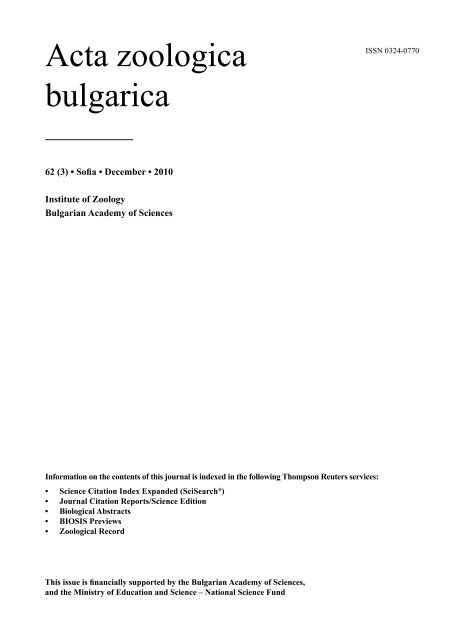
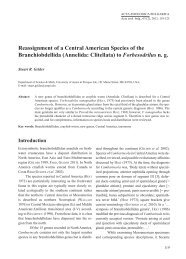
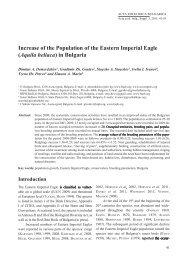
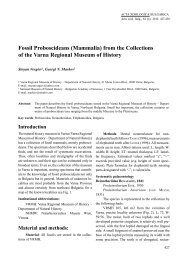
![table of contents [PDF] - Acta zoologica bulgarica](https://img.yumpu.com/52655254/1/186x260/table-of-contents-pdf-acta-zoologica-bulgarica.jpg?quality=85)
![table of contents [PDF] - Acta zoologica bulgarica](https://img.yumpu.com/52655255/1/186x260/table-of-contents-pdf-acta-zoologica-bulgarica.jpg?quality=85)
